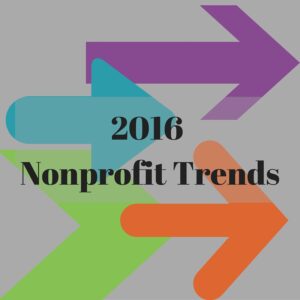 At CNE, we consider it our job to track new trends in and affecting the nonprofit sector. Framing these trends can help us better understand our local environment and give us a fresh lens through which to do what nonprofits do best: problem solve.
At CNE, we consider it our job to track new trends in and affecting the nonprofit sector. Framing these trends can help us better understand our local environment and give us a fresh lens through which to do what nonprofits do best: problem solve.
As we tip the scales towards the New Year, four trends to watch present exciting opportunities for the entire sector. Read our thoughts and join the conversation on Facebook and Twitter.
Tell us, in what ways will you capitalize on new trends bubbling up in the social sector? And what new opportunities do you see or hope to see for nonprofits in the New Year?
Our next newsletter will be out on January 7th. We wish you all a very happy holiday season.
Bring on 2016!
Nonprofit Trends to Watch in 2016
1. Board’s Role as Ambassador and Advocate: Governance at its best is about creating an environment for nonprofits to do their best work. Stand for Your Mission challenges board members to come out of board rooms and advocate for the work of their nonprofits, “The most useful – and under-utilized – asset our organizations have to advance our missions are the [board leaders] who are so passionate about what our missions seek to achieve that they have already put their time, resources, and reputations on the line.” Tim Delaney, President & CEO of the National Council of Nonprofits, states “Nonprofits provide a way for Americans to come together to solve problems. And they often do so through advocacy: simply standing up and speaking out for something they believe,” e.g. securing women’s right to vote, establishing social security, desegregating schools, securing civil rights, and more. In 2016 look for new opportunities to leverage your board members’ voices in service of your mission.
What community issues will the nonprofit sector put front and center in 2016 for our collective future?
2. Technology as a Tool for Social Change: Social change has been catapulted forward by the ubiquitous use of personal and public technology. The grassroots use of this technology, to start movements, expose injustices, raise awareness, and motivate our communities has become a necessary and critical tool to advance mission. Not only does it propel important movements like Black Lives Matter or the Arab Spring, it can aid all nonprofits in raising awareness of key issues we face and how to address them. Through its strategic use, technology also can help us increase our efficiency and efficacy.
How will your organization use technology in 2016 to advance its mission?
3. Creative Funding of Social Mission: The traditional funding streams of nonprofits are changing. From the announcement of the Chan Zuckerberg Initiative earlier this month, to the growing popularity of social impact investing, venture philanthropy and the use of social impact bonds – the capitalization of nonprofits is a landscape that continues to evolve. And not only is the way we fund our missions changing, but the ways in which we sustain our organizations continue to shift as well. Endowments are no longer regarded as the all-important panacea for which every nonprofit must strive. We must all work to create targeted financial strategies that work in the short and long term for our individual organizations.
What financial strategies will you employ in 2016 to power your mission forward?
4. Shifting from Scarcity to Abundance Mindset: Imagine forging long-term, allied partnerships with key stakeholders across the community – public, private, university, nonprofit – to solve a prevalent issue. Transforming our mindsets – from charity to social change, from fundraising to financing, from disengaged to productive board and staff, from constricting to allied funders – can transform the nature of our work. The abundance or growth mindset empowers leaders to build new alliances and leverage new resources exponentially to reach common goals. It is through this networked approach that we can and will achieve long-lasting social change.
How will you work to change the mindset of your organization in 2016?
